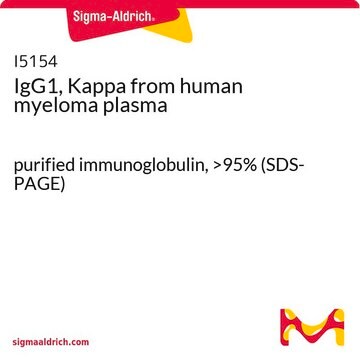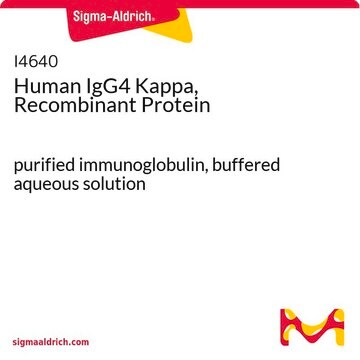M9144
IgG2a, Kappa from murine myeloma
clone UPC 10, purified immunoglobulin, buffered aqueous solution
Synonym(s):
Mouse IgG2a-κ
Sign Into View Organizational & Contract Pricing
All Photos(1)
About This Item
Recommended Products
biological source
mouse
conjugate
unconjugated
antibody form
purified immunoglobulin
clone
UPC 10, monoclonal
form
buffered aqueous solution
shipped in
dry ice
storage temp.
−20°C
target post-translational modification
unmodified
Looking for similar products? Visit Product Comparison Guide
General description
The UPC 10 tumor line that produces mouse IgG2a, kappa is tetramethylpentadecane (pristane) induced plasmacytoma originated and carried intraperitoneally in BALB/c mice.
Specificity
Antigen Specificity: β-2,6-fructosan
Trace amounts of lambda chain may be present.
Trace amounts of lambda chain may be present.
Application
IgG2a, Kappa from murine myeloma has been used in:
- Immunohistology
- Flow cytometry
- Immunostaining
- Enzyme-linked immunosorbent assay (ELISA)
- Immunohistochemistry(IHC)
- Immunoprecipitation
Physical form
Solution in 0.02 M Tris buffered saline, pH 8.0, containing 0.02% sodium azide
Disclaimer
Unless otherwise stated in our catalog or other company documentation accompanying the product(s), our products are intended for research use only and are not to be used for any other purpose, which includes but is not limited to, unauthorized commercial uses, in vitro diagnostic uses, ex vivo or in vivo therapeutic uses or any type of consumption or application to humans or animals.
Storage Class Code
12 - Non Combustible Liquids
WGK
WGK 1
Flash Point(F)
Not applicable
Flash Point(C)
Not applicable
Personal Protective Equipment
dust mask type N95 (US), Eyeshields, Gloves
Certificates of Analysis (COA)
Search for Certificates of Analysis (COA) by entering the products Lot/Batch Number. Lot and Batch Numbers can be found on a product’s label following the words ‘Lot’ or ‘Batch’.
Already Own This Product?
Find documentation for the products that you have recently purchased in the Document Library.
Customers Also Viewed
P M Glee et al.
Infection and immunity, 69(5), 2815-2820 (2001-04-09)
Adhesion interactions during hematogenous dissemination of Candida albicans likely involve a complex array of host and fungal factors. Possible C. albicans factors include changes in cell surface hydrophobicity and exposed antigens that have been shown in static adhesion assays to
Deborah Frenkel et al.
PLoS pathogens, 12(7), e1005733-e1005733 (2016-07-13)
After infection with T. brucei AnTat 1.1, C57BL/6 mice lost splenic B2 B cells and lymphoid follicles, developed poor parasite-specific antibody responses, lost weight, became anemic and died with fulminating parasitemia within 35 days. In contrast, infected C57BL/6 mice lacking
Functional expression of the chemokine receptor CCR7 on fibroblast-like synoviocytes
Bruhl H, et al.
Rheumatology (Basel), 47(12), 1771-1774 (2008)
Development and characterization of swine primary respiratory epithelial cells and their susceptibility to infection by four influenza virus types
Sreenivasan CC, et al.
Virology, 528, 152-163 (2019)
R S Mathias et al.
The American journal of physiology, 274(6), C1456-C1465 (1998-06-05)
The effect of inositol 1,4,5-trisphosphate (IP3) receptor blockade on platelet-derived growth factor (PDGF), fibroblast growth factor (FGF), endothelin-1 (ET-1), or alpha-thrombin receptor-mediated intracellular Ca2+ (Ca2+i) release was examined using fura 2 microspectrofluorometry in single Chinese hamster ovary cells and myoblasts.
Our team of scientists has experience in all areas of research including Life Science, Material Science, Chemical Synthesis, Chromatography, Analytical and many others.
Contact Technical Service













